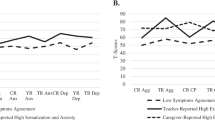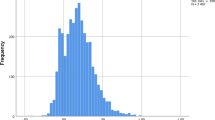Abstract
Objective
To evaluate discrepancies between parent and child reports on youth’s emotional and behavioral problems in a representative, community based sample of Greek 18-year-olds, and to identify associated factors.
Methods
A total of 2,927 completed pairs of parent-child questionnaires were studied, including the child behavior checklist (CBCL) and the youth self-report (YSR). Linear regression analysis was used to identify both child and parental characteristics significantly associated with parent/child disagreement on scores for youth’s Internalising, Externalising and Total problems scales for both genders separately.
Results
Although there was a strong correlation between scores on the YSR and CBCL corresponding scales, parent/child discrepancies were more likely to occur when the later: had good academic performance, were dissatisfied from their self-image or their life. Parental factors that influence discrepancies in parent/child scale scores were: low paternal education for both genders, father being the informant for boys, and maternal stress and lack of awareness of leisure activities for girls.
Conclusion
The associations found highlight the contributions of both parents and children to the discrepancies on emotional and behavioral problems in adolescence. This study may facilitate constructive parenting practices through generations.
Similar content being viewed by others
References
Achenbach TM (1991) Manual for the youth self-report and 1991 profile. University of Vermont, Department of Psychiatry, Burlington
Achenbach TM, Mc Conoghy SH, Howell CT (1987) Child/adolescent behavioural and emotional problems: implications of cross-informant correlations for situational specificity. Psychol Bull 101:213–232
Ackard D, Neumark-Sztainer D, Story M, Perry C (2006) Parent-child connectedness and behavioural and emotional health among adolescents. Am J Prev Med 30:59–66
Berger LE, Jodl KM, Allen JP, McElhaney KB, Kuperminc GP (2005) When adolescents disagree with others about their symptoms: differences in attachment organization as an explanation of discrepancies between adolescent, parent, and peer reports of behavior problems. Dev Psychopathol 17(2):509–528
Berg-Nielsen TS, Vika A, Dahl AA (2003) When adolescents disagree with their mothers: CBCL-YSR discrepancies related to maternal depression and adolescent self-esteem. Child Care Health Dev 29:207–213
Bidaut-Russell M, Reich W, Cottler LB, Robins LN, Compton WM, Mattison RE (1995) The diagnostic interview schedule for children (PC-DISC v.3.0): parents and adolescents suggest reasons for expecting discrepant answers. J Abnorm Child Psychol 23:641–659
Cremeens J, Eiser C, Blades M (2006) Factors influencing agreement between child self-report and parent proxy-reports on the pediatric quality of life inventory 4.0 (PedsQL) generic core scales. Health Qual Life Outcomes 4:58–65
Duke N, Ireland M, Borowsky IW (2005) Identifying psychosocial problems among youth: factors associated with youth agreement on a positive parent completed PSC-17. Child Care Health Dev 31:563–573
European Birth Lifecourse Studies (Euro-Blcs). http://www1.imperial.ac.uk/medicine/about/divisions/ephpc/eph/projects/cdel/euroblcs/. Accessed 15 Oct 2007
Ferdinand RF, van der Ende J, Verhulst FC (2006) Prognostic value of parent-adolescent disagreement in a referred sample. Eur Child Adolesc Psychiatry 15:156–162
Frank SJ, Van Egeren LA, Fortier JL, Chase P (2000) Structural, relative, and absolute agreement between parents’ and adolescent inpatients’ reports of adolescent functional impairment. J Abnorm Child Psychol 28:395–402
Fröjd S, Marttunen M, Pelkonen M, von der Pahlen B, Kaltiala-Heino R (2007) Adult and peer involvement in help-seeking for depression in adolescent population a two-year follow-up in Finland. Soc Psychiatry Psychiatr Epidemiol 42:945–952
Heneghan AM, Mercer M, DeLeone NL (2004) Will mothers discuss parenting stress and depressive symptoms with their child’s pediatrician? Pediatrics 113:460–467
Herjanic B, Reich W (1997) Development of a structured psychiatric interview for children: agreement between child and parent on individual symptoms. J Abnorm Child Psychol 25:21–31
Kapi A, Veltsista A, Kavadias G, Lekea V, Bakoula C (2007) Social determinants of self reported emotional and behavioural problems in Greek adolescents. Soc Psychiatry Psychiatr Epidemiol 42:594–598
Luoma I, Koivisto AM, Tamminen T (2004) Fathers’ and mothers’ perceptions of their child and maternal depressive symptoms. Nord J Psychiatry 58:205–211
Martin JL, Ford CB, Dyer-Friedman J, Tang J, Huffman LC (2004) Patterns of agreement between parent and child ratings of emotional and behavioral problems in an outpatient clinical setting: when children endorse more problems. J Dev Behav Pediatr 25:150–155
Overbeek G, Ten Have M, Vollebergh W, De Graaf R (2007) Parental lack of care and overprotection longitudinal associations with DSM-III-R disorders. Soc Psychiatry Psychiatr Epidemiol 42:87–93
Phares V (1997) Accuracy of informants: do parents think that mother knows best. J Abnorm Child Psychol 25(2):165–171
Roussos A, Francis K, Zoubou V, et al. (2001) The standardization of Achenbach’s youth self-report in Greece in a national sample of high school students. Eur Child Adolesc Psychiatry 10:47–53
Roussos A, Karantanos G, Richardson C, et al (1999) Achenbach’s child behavior checklist and teachers’ report form in a normative sample of Greek children 6–12 years old. Eur Child Adolesc Psychiatry 8:165–172
Rubio-Stipec M, Canino G, Shrout P, Dulcan M, Freeman D, Bravo M (1994) Psychometric properties of parents and children as informants in child psychiatry epidemiology with the Spanish diagnostic interview schedule for children (DISC.2). J Abnorm Child Psychol 22:703–720
Rubio-Stipec M, Fitzmaurice G, Murphy J, Walker A (2003) The use of multiple informants in identifying the risk factors of depressive and disruptive disorders. are they interchangeable? Soc Psychiatry Psychiatr Epidemiol 38:51–58
Seiffge-Krenke I, Kollmar F (1998) Discrepancies between mothers’ and fathers’ perceptions of sons’ and daughters’ problem behaviour: a longitudinal analysis of parent- adolescent agreement on internalizing and externalizing problem behaviour. J Child Psychol Psychiatr 39:687–697
Sourander A, Hestelä L, Helenius H (1999) Parent-adolescent agreement on emotional and behavioral problems. Soc Psychiatry Psychiatr Epidemiol 34:657–663
Sourander A, Pihlakoski L, Arooma M, Rautava P, Helenius H, Sillanpää M (2006) Early predictors of parent- and self reported perceived global psychological difficulties among adolescents. A prospective study from age 3 to age 15. Soc Psychiatry Psychiatr Epidemiol 41:173–182
Stefanis NC, Delespaul P, Henquet C, Bakoula C, Stefanis CN, Van Os J (2004) Early adolescent cannabis exposure and positive and negative dimensions of psychosis. Addiction 99(10):1333–1341
Treutler CM, Epkins CC (2003) Are discrepancies among child mother and father reports on children’s behavior related to parents’ psychological status and aspects of parent child relationships? J Abnorm Child Psychol 31:13–27
Verhulst FC, van der Ende J (1992) Agreement between parents’ reports and adolescents’ self-reports of problem behavior. J Child Psychol Psychiatry 33(6):1011–1023
Waters E, Stewart-Brown S, Fitzpatrick R (2003) Agreement between adolescent self-report and parent reports of health and well-being: results of an epidemiological study. Child Care Health Dev 29:501–509
Yang H, Stanton B, Cottrel L, et al (2006) Parental awareness of adolescent risk involvement: implications of overestimates and underestimates. J Adolesc Health 39:353–361
Acknowledgments
This research was funded by the European Commission Quality of Life and Management of Living Resources Program (contract number QLG1-CT-2000-01643) and the Academy of Athens. The authors would like to thank all the respondents who participated in this study for their contribution.
Author information
Authors and Affiliations
Corresponding author
Rights and permissions
About this article
Cite this article
Vassi, I., Veltsista, A., Lagona, E. et al. The generation gap in numbers: parent-child disagreement on youth’s emotional and behavioral problems. Soc Psychiat Epidemiol 43, 1008–1013 (2008). https://doi.org/10.1007/s00127-008-0389-y
Received:
Accepted:
Published:
Issue Date:
DOI: https://doi.org/10.1007/s00127-008-0389-y




